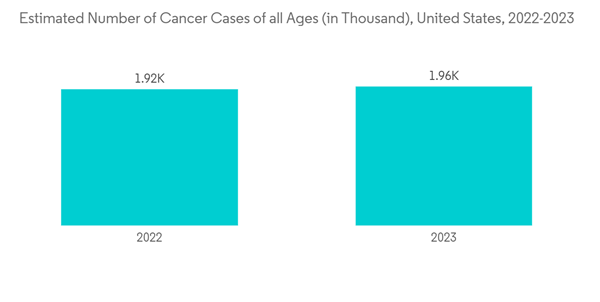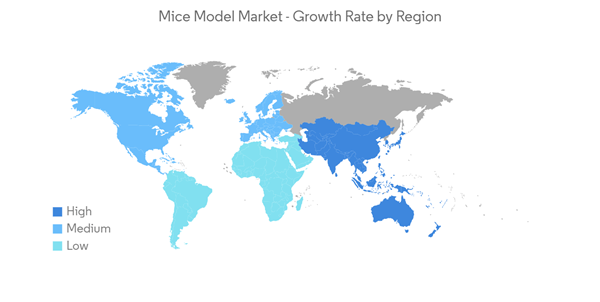The mice model market is expected to register a CAGR of 6.8% over the forecast period.
This product will be delivered within 2 business days.
Key Highlights
- The COVID-19 pandemic had a significant impact on the market studied. Research laboratories and biopharmaceutical industries extensively used mice models in preclinical development. For instance, according to an article published by Methods of Molecular Biology in October 2022, a small rodent animal model using K18 hACE2 transgenic mice had been represented as an option to understand the pathogenicity of natural SARS-CoV-2 strains. It had been described as a Variants of Concern (VoC) that applied to the identification and characterization of prophylactic (vaccine) and therapeutic (antiviral and neutralizing monoclonal antibodies) strategies for the prevention or treatment of SARS-CoV-2 infection or its associated COVID-19 disease. Thus, the adoption of mouse models to analyze the progress made since the discovery of SARS-CoV-2 in developing and applying relevant mouse models had been anticipated to drive market growth during the pandemic. However, as the COVID-19 cases started to decline, the market had begun to show average pre-pandemic level growth and was likely to continue its significant growth rate during the forecast period.
- Factors such as increasing innovations in mice models, rising demand for personalized medicine, and a growing pipeline of pharmaceutical and biopharmaceutical companies are driving the growth of the mice model market. For instance, an article published by Molecular Neurodegeneration in June 2022 stated that the genetic engineering of novel mouse models using knock-in approaches addresses some of the limitations of genetic mutations. Also, the article mentioned in its conclusion that the scientific community should use the open-access mouse model as a resource to study disease-relevant biology. Thus, such instances are anticipated to boost the demand for mice models, further driving the market growth.
- In addition, the rising demand for precision medicine is driving the growth. For instance, in April 2022, an article published in the journal Nature Medicine reported that the increasing use of genomic profiling for diagnosis and therapy guidance in many tumor types had increased the use of precision medicine in cancer patients. With the increased demand for precision medicine, the utilization of mouse models will also increase, leading to market growth.
- Furthermore, several key market players have also been investing in the market's growth. For instance, in January 2022, Inotiv acquired Orient BioResource Center, Inc. from Orient Bio, Inc., a preclinical CRO and animal model supplier based in Seongnam, South Korea. Orient BioResource Center is a primate quarantine & holding facility located near Alice, Texas.
- Hence, as per the abovementioned factors, the mice model market is anticipated to grow over the forecast period. However, alternatives to animal testing and regulations for the ethical use of animals are expected to restrain the market's growth.
Mice Model Market Trends
The Oncology Segment is Expected to Hold a Significant Market Share Over the Forecast Period
- The primary factor propelling the oncology segment's growth is the rising burden of cancer, coupled with the increasing adoption of mice models in various oncology-related drug and vaccine development research. For instance, in February 2021, ExpreS2ion Biotech Holding and the University of Bologna entered into a research collaboration agreement that covers testing of the novel HER2-cVLP breast cancer vaccine program, including the selected lead candidate ES2B-C001 in proprietary state-of-the-art breast cancer mice models.
- In addition, the increasing research using mice models for drug discovery for cancer is also anticipated to contribute to the market growth. For example, as per the article published by OncoImmunology in April 2022, the researchers utilized the Diversity Outbred (DO) and Collaborative Cross (CC) mouse models to investigate the outcomes of the immune checkpoint inhibitors (ICI) for a variety of malignancies. The study researchers purchased the DO mice models from the Jackson Laboratory and all CC mice from the Systems Genetics Core Facility at the University of North Carolina. Such adoption of mice models in cancer research is expected to contribute to segment growth.
- Product launches by the key market players support the market growth over the forest period. For instance, in January 2023, Taconic Biosciences launched the huNOG-EXL EA (Early Access) humanized immune system (HIS) mouse. This product expands Taconic's widely used HIS portfolio. huNOG-EXL EA significantly lengthens the study window during which a myeloid-lineage HIS mouse model can be used successfully.
- Thus, the abovementioned factor is expected to boost the segment growth over the forecast period.
North America is Expected to Hold a Significant Growth in the Mice Model Market
- North America is anticipated to witness growth over the forecast period due to increased healthcare expenditure, increased research and development, and a rising prevalence of infectious or non-communicable diseases. The market players in the country are involved in multiple activities, such as collaborations and agreements, which are anticipated to drive market growth over the forecast period.
- For instance, in May 2021, the SDS Alliance launched a Mouse Model Project with the Jackson Laboratory. The project will create the mouse model (introduce SDS disease genes into mice using CRISPR and breed) for USD 150,000 and characterize the model (such as how SDS present in mice compared to human SDS or whether the mice get pancreatic problems or neutropenia) for another USD 150,000.
- In addition, in November 2021, Tranquis Therapeutics, a private immuno-neurology company, declared positive preclinical data on its lead program TQS-168 at the Neuroscience 2021 meeting. The data illustrate the potential of TQS-168 for treating amyotrophic lateral sclerosis (ALS). TQS-168 showed increased median survival and decreased pro-inflammatory cytokines and inflammatory monocytes in a widely used SOD1-G93A transgenic mouse model and demonstrated a similar decrease in inflammatory monocytes in blood from ALS patients. Such advances in the region are anticipated to fuel market growth.
- Therefore, owing to the abovementioned factors, North America is predicted to witness growth over the forecast period.
Mice Model Industry Overview
The mice model market is moderately concentrated in nature due to the presence of companies operating globally as well as regionally. The competitive landscape includes an analysis of a few international as well as local companies that hold market shares and are well known, including Allentown LLC, Charles River Laboratories International Inc., ENVIGO, Genoway, Harbour Biomed, and The Jackson Laboratory, among others.Additional Benefits:
- The market estimate (ME) sheet in Excel format
- 3 months of analyst support
This product will be delivered within 2 business days.
Table of Contents
1 INTRODUCTION
4 MARKET DYNAMICS
5 MARKET SEGMENTATION (Market Size by Value - USD million)
6 COMPETITIVE LANDSCAPE
Companies Mentioned (Partial List)
A selection of companies mentioned in this report includes, but is not limited to:
- Allentown LLC
- Charles River Laboratories International Inc.
- ENVIGO
- Genoway
- Harbour Biomed
- Horizon Discovery Group PLC (Sage Labs Inc.)
- Ingenious Targeting Laboratory
- Janvier Labs
- Ozgene Pty Ltd
- PolyGene
- Taconic Biosciences Inc.
- The Andersons Inc.
- The Jackson Laboratory
- Trans Genic Inc.
Methodology

LOADING...










